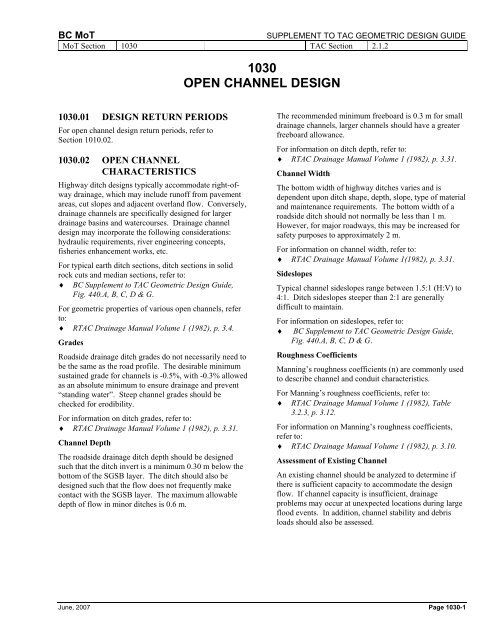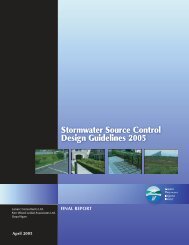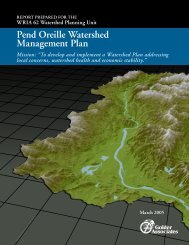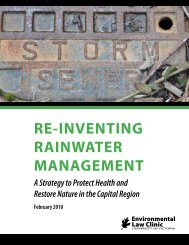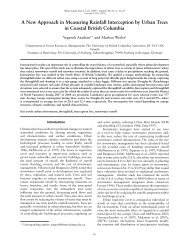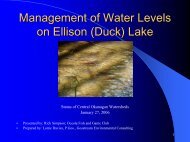1000 Hydraulics Chapter - Ministry of Transportation
1000 Hydraulics Chapter - Ministry of Transportation
1000 Hydraulics Chapter - Ministry of Transportation
You also want an ePaper? Increase the reach of your titles
YUMPU automatically turns print PDFs into web optimized ePapers that Google loves.
BC MoT<br />
SUPPLEMENT TO TAC GEOMETRIC DESIGN GUIDE<br />
MoT Section 1030 TAC Section 2.1.2<br />
1030<br />
OPEN CHANNEL DESIGN<br />
1030.01 DESIGN RETURN PERIODS<br />
For open channel design return periods, refer to<br />
Section 1010.02.<br />
1030.02 OPEN CHANNEL<br />
CHARACTERISTICS<br />
Highway ditch designs typically accommodate right-<strong>of</strong>way<br />
drainage, which may include run<strong>of</strong>f from pavement<br />
areas, cut slopes and adjacent overland flow. Conversely,<br />
drainage channels are specifically designed for larger<br />
drainage basins and watercourses. Drainage channel<br />
design may incorporate the following considerations:<br />
hydraulic requirements, river engineering concepts,<br />
fisheries enhancement works, etc.<br />
For typical earth ditch sections, ditch sections in solid<br />
rock cuts and median sections, refer to:<br />
♦ BC Supplement to TAC Geometric Design Guide,<br />
Fig. 440.A, B, C, D & G.<br />
For geometric properties <strong>of</strong> various open channels, refer<br />
to:<br />
♦ RTAC Drainage Manual Volume 1 (1982), p. 3.4.<br />
Grades<br />
Roadside drainage ditch grades do not necessarily need to<br />
be the same as the road pr<strong>of</strong>ile. The desirable minimum<br />
sustained grade for channels is -0.5%, with -0.3% allowed<br />
as an absolute minimum to ensure drainage and prevent<br />
“standing water”. Steep channel grades should be<br />
checked for erodibility.<br />
For information on ditch grades, refer to:<br />
♦ RTAC Drainage Manual Volume 1 (1982), p. 3.31.<br />
Channel Depth<br />
The roadside drainage ditch depth should be designed<br />
such that the ditch invert is a minimum 0.30 m below the<br />
bottom <strong>of</strong> the SGSB layer. The ditch should also be<br />
designed such that the flow does not frequently make<br />
contact with the SGSB layer. The maximum allowable<br />
depth <strong>of</strong> flow in minor ditches is 0.6 m.<br />
The recommended minimum freeboard is 0.3 m for small<br />
drainage channels, larger channels should have a greater<br />
freeboard allowance.<br />
For information on ditch depth, refer to:<br />
♦ RTAC Drainage Manual Volume 1 (1982), p. 3.31.<br />
Channel Width<br />
The bottom width <strong>of</strong> highway ditches varies and is<br />
dependent upon ditch shape, depth, slope, type <strong>of</strong> material<br />
and maintenance requirements. The bottom width <strong>of</strong> a<br />
roadside ditch should not normally be less than 1 m.<br />
However, for major roadways, this may be increased for<br />
safety purposes to approximately 2 m.<br />
For information on channel width, refer to:<br />
♦ RTAC Drainage Manual Volume 1(1982), p. 3.31.<br />
Sideslopes<br />
Typical channel sideslopes range between 1.5:1 (H:V) to<br />
4:1. Ditch sideslopes steeper than 2:1 are generally<br />
difficult to maintain.<br />
For information on sideslopes, refer to:<br />
♦ BC Supplement to TAC Geometric Design Guide,<br />
Fig. 440.A, B, C, D & G.<br />
Roughness Coefficients<br />
Manning’s roughness coefficients (n) are commonly used<br />
to describe channel and conduit characteristics.<br />
For Manning’s roughness coefficients, refer to:<br />
♦ RTAC Drainage Manual Volume 1 (1982), Table<br />
3.2.3, p. 3.12.<br />
For information on Manning’s roughness coefficients,<br />
refer to:<br />
♦ RTAC Drainage Manual Volume 1 (1982), p. 3.10.<br />
Assessment <strong>of</strong> Existing Channel<br />
An existing channel should be analyzed to determine if<br />
there is sufficient capacity to accommodate the design<br />
flow. If channel capacity is insufficient, drainage<br />
problems may occur at unexpected locations during large<br />
flood events. In addition, channel stability and debris<br />
loads should also be assessed.<br />
June, 2007 Page 1030-1


